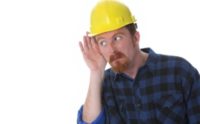An employee may be exposed to work-related noise eight hours a day, 40 hours a week, for a 40-year career. Hearing loss caused by prolonged exposure to hazardous noise occurs gradually, over time, and a worker may not detect it until it is too late.
Although we cannot go back in time and undo the damage, we can take action that makes a difference right now. Hearing loss that is caused by prolonged exposure to hazardous noise (noise-induced hearing loss, or NIHL) is 100 percent preventable.
Dangerous levels
Even a small amount of hearing damage can have a dramatic effect on a person's ability to discern sounds. Recognizing dangerous levels of noise is the first step towards hearing safety. But what are considered dangerous levels of noise?According to the World Health Organization, the prolonged exposure to noise of 85 decibels for eight consecutive hours or more can lead to a hearing loss. Additionally, being exposed to a louder noise but for a shorter period of time can also be damaging. Many operations such as grinding, stamping and other tasks that require heavy machinery are all above the permissible exposure level.
Certain types of sound that are the same decibel level may have different effects on our hearing. For example, a grinder and stamping machine have similar decibel levels. But the grinder is a greater hazard to hearing because of an aspect of sound known as frequency. Higher frequency sounds are of the most concern because they cause the most damage to the nerve endings inside the cochlea.
Program in place
OSHA regulation 1910.95 is considered the general standard for hearing conservation and protection in the United States. The standard requires workplaces to have a hearing conservation program in place, including personal protective equipment (PPE) designed for hearing protection. Elements of a program include:Audiometric evaluation - Workers, as part of their job, may be required to have an audiometric evaluation. The purpose of this test is to check responses to tones of various frequencies in both ears. A worker's initial audiometric test is called the baseline. Future tests, when compared to the baseline, will determine if hearing loss is occurring or being prevented. If a shift of an average of 10 decibels or more occurs in an individual's hearing at 2,000, 3,000, or 4,000 Hertz, further testing may be required to determine if the results are temporary or permanent.
Engineering Controls - The first line of defense in a hearing conservation program, engineering controls reduce the noise levels of machinery in a number of ways. Mufflers on heavy machinery, moving noisy machinery to an area of the plant away from employees, equipment enclosures, or the use of sound-absorbing material can all reduce the effects of high levels of noise. If engineering controls are not feasible or applicable, the use of personal hearing protection such as earplugs or earmuffs is required to reduce noise levels.
PPE - As a rule of thumb, a work environment where you have to raise your voice to be heard by someone less than two feet away requires the use of hearing protection. Hearing protection comes primarily in two forms: earplugs and earmuffs.
Earplugs are typically made of foam or premolded plastic. They work by forming a seal inside the ear canal to prevent high levels of noise from reaching the cochlea. All earplugs are given a noise reduction rating (NRR) by the manufacturer. Make sure the plugs you use effectively reduce the decibels to the permissible exposure level.
Unlike plugs, earmuffs cover the entire ear. Because the seal of the earmuff is around the outside of the ear, anything that comes between the ear and the muff can reduce its effectiveness. Safety glasses, long hair and certain hats can all cause an improper seal.
When using personal hearing protection, workers should understand that there will be a period of adjustment. Often your own voice seems amplified when using plugs or muffs. While this may seem annoying at first, remember that earplugs are much easier to get used to than hearing aids.
Lasting benefits
When a proper hearing conservation program is followed, studies indicate that employees generally feel better, have more energy and a more positive attitude. We can't turn back the clock when it comes to our ability to hear. But we can protect our hearing now through the choices we make. Protect your hearing - the benefits will last a lifetime.SIDEBAR: How the ear hears
To fully understand the effect excessive noise can have on our hearing, it is important to first know how the ear works.When a sound is generated, vibrations or sound waves are sent speeding through the air. These sound waves are then funneled into the auditory canal where they reach the eardrum. The waves cause the eardrum to vibrate, which in turn moves three tiny bones known as the hammer, anvil and stirrup. The stirrup passes the vibrations into a coiled tube called the cochlea. The fluid-filled cochlea contains thousands of hair-like nerve endings. When the fluid in the cochlea vibrates, the nerve endings change the vibrations into messages sent to the brain.
When unprotected ears are exposed to hazardous levels of noise, the nerve endings inside the cochlea become temporarily damaged, which may result in a condition known as tinnitus. Tinnitus is an annoying condition with symptoms ranging from a constant whistling or ringing inside your ears to temporary hearing loss. The condition can be severe and debilitating; even sleep can become difficult.
The extent of hearing loss damage depends on the intensity and duration of the noise. If hazardous exposure continues, eventually the nerve endings will not be able to recover. This type of impairment to the inner ear is known as sensory neural hearing loss, and is permanent.
